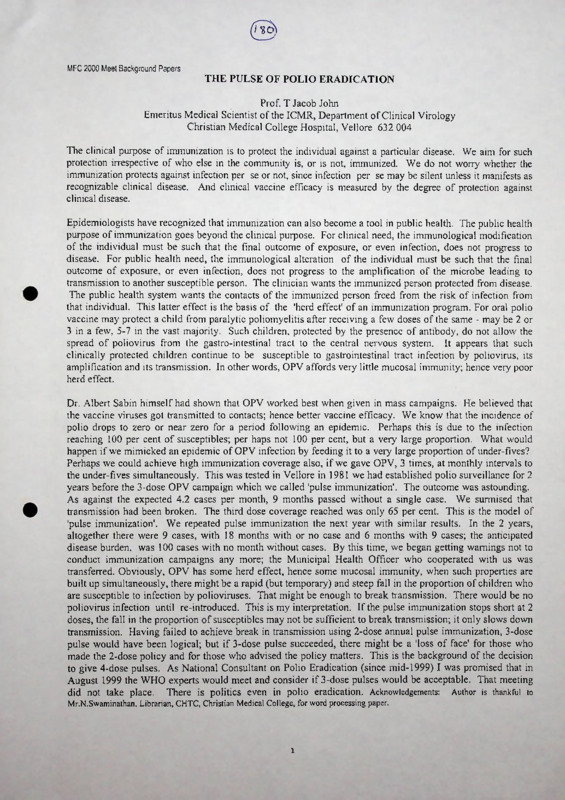The Pulse of Polio Eradication
Item
- Title
- The Pulse of Polio Eradication
- Creator
- T Jacob John
- Date
- 2000
- extracted text
-
/ w.
MFC 2000 Meet Background Papers
THE PULSE OF POLIO ERADICATION
Prof. T Jacob John
Emeritus Medical Scientist of the ICMR, Department of Clinical Virology
Christian Medical College Hospital, Vellore 632 004
The clinical purpose of immunization is to protect the individual against a particular disease. We aim for such
protection irrespective of who else in the community is, or is not, immunized. We do not worry whether the
immunization protects against infection per se or not, since infection per se may be silent unless it manifests as
recognizable clinical disease. And clinical vaccine efficacy is measured by the degree of protection against
clinical disease.
Epidemiologists have recognized that immunization can also become a tool in public health. The public health
purpose of immunization goes beyond the clinical purpose. For clinical need, the immunological modification
of the individual must be such that the final outcome of exposure, or even infection, does not progress to
disease. For public health need, the immunological alteration of the individual must be such that the final
outcome of exposure, or even infection, does not progress to the amplification of the microbe leading to
transmission to another susceptible person. The clinician wants the immunized person protected from disease.
The public health system wants the contacts of the immunized person freed from the risk of infection from
that individual. This latter effect is the basis of the 'herd effect' of an immunization program. For oral polio
vaccine may protect a child from paralytic poliomyelitis after receiving a few doses of the same - may be 2 or
3 in a few, 5-7 in the vast majority. Such children, protected by the presence of antibody, do not allow the
spread of poliovirus from the gastro-intestinal tract to the central nervous system. It appears that such
clinically protected children continue to be susceptible to gastrointestinal tract infection by poliovirus, its
amplification and its transmission. In other words, OPV affords very little mucosal immunity; hence very poor
herd effect.
Dr. Albert Sabin himself had shown that OPV worked best when given in mass campaigns. He believed that
the vaccine viruses got transmitted to contacts; hence better vaccine efficacy. We know that the incidence of
polio drops to zero or near zero for a period following an epidemic. Perhaps this is due to the infection
reaching 100 per cent of susceptibles; per haps not 100 per cent, but a very large proportion. What would
happen if we mimicked an epidemic of OPV infection by feeding it to a very large proportion of under-fives?
Perhaps we could achieve high immunization coverage also, if we gave OPV, 3 times, at monthly intervals to
the under-fives simultaneously. This was tested in Vellore in 1981 we had established polio surveillance for 2
years before the 3-dose OPV campaign which we called 'pulse immunization'. The outcome was astounding.
As against the expected 4.2 cases per month, 9 months passed without a single case. We surmised that
transmission had been broken. The third dose coverage reached was only 65 per cent. This is the model of
'pulse immunization'. We repeated pulse immunization the next year with similar results. In the 2 years,
altogether there were 9 cases, with 18 months with or no case and 6 months with 9 cases; the anticipated
disease burden, was 100 cases with no month without cases. By this time, we began getting warnings not to
conduct immunization campaigns any more; the Municipal Health Officer who cooperated with us was
transferred. Obviously, OPV has some herd effect, hence some mucosal immunity, when such properties are
built up simultaneously, there might be a rapid (but temporary) and steep fall in the proportion of children who
are susceptible to infection by polioviruses. That might be enough to break transmission. There would be no
poliovirus infection until re-introduced. This is my interpretation. If the pulse immunization stops short at 2
doses, the fall in the proportion of susceptibles may not be sufficient to break transmission; it only slows down
transmission. Having failed to achieve break in transmission using 2-dose annual pulse immunization, 3-dose
pulse would have been logical; but if 3-dose pulse succeeded, there might be a 'loss of face' for those who
made the 2-dose policy and for those who advised the policy matters. This is the background of the decision
to give 4-dose pulses. As National Consultant on Polio Eradication (since mid-1999) I was promised that in
August 1999 the WHO experts would meet and consider if 3-dose pulses would be acceptable. That meeting
did not take place. There is politics even in polio eradication. Acknowledgements: Author is thankful to
Mr.N.Swaminathan, Librarian, CHTC, Christian Medical College, for word processing paper.
1
Position: 2369 (4 views)

